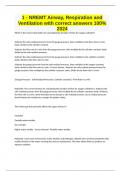1 - NREMT Airway, Respiration and
Ventilation with correct answers 100%
2024
Which is the correct description for calculating the duration of flow for oxygen cylinders?
Subtract the safe residual pressure from the gauge pressure, then multiply by the flow rate in L/min,
lastly, divide by the cylinder constant
Subtract the flow rate in L/min from the gauge pressure, then multiply by the cylinder constant, lastly,
divide by the safe residual pressure
Subtract the safe residual pressure from the gauge pressure, then multiply by the cylinder constant,
lastly, divide by the flow rate in L/min
Subtract the gauge pressure from the safe residual pressure, then multiply by the oxygen constant,
lastly, divide by the flow rate in L/min - Correct Answer Subtract the safe residual pressure from the
gauge pressure, then multiply by the cylinder constant, lastly, divide by the flow rate in L/min
[(Gauge Pressure - Safe Residual Pressure) x Cylinder constant] / Flow Rate in L/min
Rationale: The correct formula for calculating the duration of flow for oxygen cylinders is: Subtract the
safe residual pressure from the gauge pressure, then multiply by the cylinder constant, lastly, divide by
the flow rate in L/min. Some formulas do not include a safe residual pressure, but a residual pressure
should always be included as a margin for patient safety.
The irritant gas that primarily affects the upper airway is?
Insoluble
Partially water-soluble
Non-soluble
Highly water soluble - Correct Answer Partially water-soluble
Rationale: Gases such as Ammonia, Sulfur dioxide, and Hydrogen chloride have chemical properties that
readily dissolve in the water covering the mucous membranes. This then allows them to produce an
aqueous solution.
,You have an unconscious patient. What do you do?
Start CPR immediately
Baseline vitals, primary assessment, and secondary assessment
ABCs, History taking, Rapid full body scan
ABC, Baseline vitals, Transport decision - Correct Answer ABCs, History taking, Rapid full body scan
Rationale: According to the NES, the ABCs are part of the primary survey, which is then followed by
history taking, and then the secondary assessment. A rapid full body scan is the first step of the
secondary assessment. The rapid full body scan may be incorporated into the primary survey in order to
determine life threats. You would not start CPR as the patient is only unconscious. They may be
breathing with a pulse. Baseline vitals come after the primary and secondary assessments. Transport
decision also comes before vital signs.
The functions of the respiratory system include all of the following except:
Ventilation
Respiration
Bronchiole/venous gas exchange
Alveolar/capillary gas exchange - Correct Answer Bronchiole/venous gas exchange
Rationale: The functions of the respiratory system include:
-ventilation,
-respiration,
-alveolar/capillary gas exchange, and buffer.
Which of these items should you use during resuscitation of a child while using a BVM?
AED
,BIRQ
A folded towel under the child's shoulders
Nasal cannula at 12 lpm - Correct Answer A folded towel under the child's shoulders
Rationale: National registry requires the use of a folded towel during testing. By doing so, it allows you
to place the patients airway into proper positioning for airway management.
Which of the following choices would be included in the lower airway?
Trachea - alveoli - uvula
Epiglottis - oropharynx - vestibular fold
Trachea - bronchial tree - alveoli
Vocal cords - pharynx - epiglottis - Correct Answer Trachea - bronchial tree - alveoli
Rationale: The lower airway is the trachea, bronchial tree, and alveoli. Everything above the trachea is
considered upper airway.
When inserting a nasopharyngeal airway, the airway should be placed in the ____________ nostril, with
the curvature of the device following the curve of the __________ of the nose.
larger, roof
smaller, roof
larger, floor
smaller, floor - Correct Answer larger, floor
Rationale: When inserting a nasopharyngeal airway, the airway should be placed in the larger nostril,
with the curvature of the device following the curve of the floor of the nose.
You arrive on scene with your partner Zelda to a restaurant where a woman is apparently having a
reaction to the seafood from the buffet. She is having trouble breathing and her lips are swollen. Zelda
, hands you an adult EPI pen and you inject the patient into the thigh and hold it there for about 3
seconds. How long will the injection likely be effective?
30-60 minutes
1-2 hours
10-20 minutes
24 hours - Correct Answer 10-20 minutes
Rationale: Plan for it lasting only 10-20 minutes. Having additional dosages on hand during transport is a
necessity.
Gastric distention may interfere with ventilations while in the field and can cause?
Decreased lung expansion
Gastric rupture
Increased resistance to BVM ventilations
All of the above - Correct Answer All of the above
Rationale: All are complications of gastric distention. As gastric distention occurs, the diaphragm pushes
up on the base of the lungs causing a decrease in lung expansion. When lung expansion is decresed,
BVM ventilations will become more resistant.
Which of the following is not a typical disease process that would inhibit internal respiration?
Pneumonia
Pulmonary edema
Hypertension
Emphysema - Correct Answer Hypertension
Rationale: Typical disease processes that can inhibit internal respiration include:




